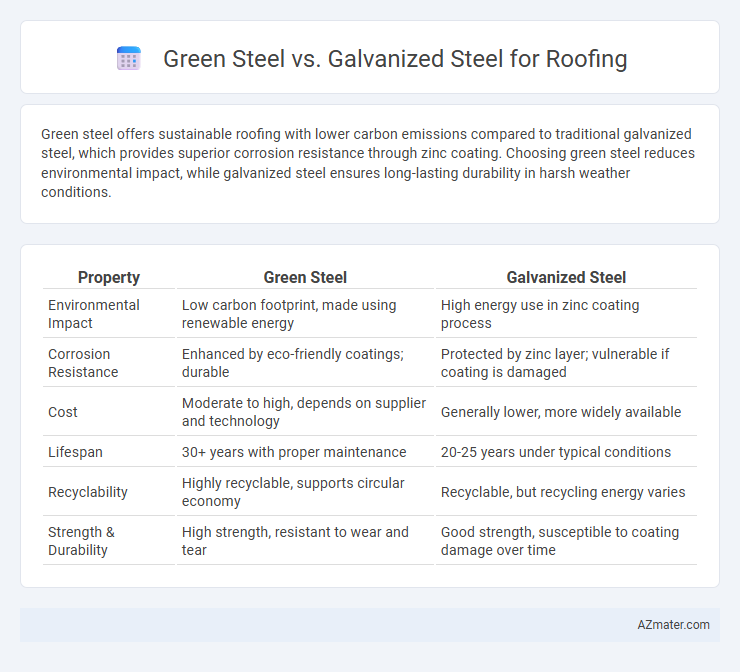Green steel offers sustainable roofing with lower carbon emissions compared to traditional galvanized steel, which provides superior corrosion resistance through zinc coating. Choosing green steel reduces environmental impact, while galvanized steel ensures long-lasting durability in harsh weather conditions.
Table of Comparison
| Property | Green Steel | Galvanized Steel |
|---|---|---|
| Environmental Impact | Low carbon footprint, made using renewable energy | High energy use in zinc coating process |
| Corrosion Resistance | Enhanced by eco-friendly coatings; durable | Protected by zinc layer; vulnerable if coating is damaged |
| Cost | Moderate to high, depends on supplier and technology | Generally lower, more widely available |
| Lifespan | 30+ years with proper maintenance | 20-25 years under typical conditions |
| Recyclability | Highly recyclable, supports circular economy | Recyclable, but recycling energy varies |
| Strength & Durability | High strength, resistant to wear and tear | Good strength, susceptible to coating damage over time |
Introduction to Green Steel and Galvanized Steel
Green steel, produced using environmentally friendly methods such as electric arc furnaces powered by renewable energy, offers reduced carbon emissions and sustainable roofing solutions. Galvanized steel, coated with a layer of zinc to prevent corrosion, remains a durable and cost-effective choice for roofing projects. Both materials provide strong structural integrity, but green steel emphasizes eco-conscious manufacturing, while galvanized steel prioritizes long-lasting protection against rust.
Manufacturing Processes: Green Steel vs. Galvanized Steel
Green steel is manufactured using low-carbon methods, such as hydrogen-based direct reduction or electric arc furnaces powered by renewable energy, significantly reducing CO2 emissions compared to traditional steel production. Galvanized steel involves coating conventional steel with a layer of zinc through hot-dip galvanization or electro-galvanization, enhancing corrosion resistance but relying on carbon-intensive steel-making processes. The manufacturing of green steel emphasizes sustainability and environmental impact, while galvanized steel focuses on durability and protection against rust through surface treatment.
Environmental Impact: Comparing Carbon Footprints
Green steel significantly reduces carbon footprints by utilizing hydrogen or electric arc furnace methods, cutting CO2 emissions by up to 95% compared to traditional steel production. Galvanized steel, while providing corrosion resistance through zinc coating, relies on conventional blast furnace processes that emit higher levels of greenhouse gases. Choosing green steel for roofing contributes to more sustainable construction by minimizing environmental impact through lower embodied carbon.
Durability and Longevity in Roofing Applications
Green steel roofing offers superior durability due to its eco-friendly manufacturing process that enhances corrosion resistance and structural integrity. Galvanized steel provides strong protection against rust through its zinc coating but may degrade faster in harsh weather conditions compared to green steel. Longevity in roofing applications favors green steel, which can last upwards of 50 years with minimal maintenance, whereas galvanized steel typically endures around 20-30 years depending on environmental exposure.
Cost Analysis: Upfront and Lifecycle Expenses
Green steel roofing, produced with reduced carbon emissions, often presents higher upfront costs compared to galvanized steel due to advanced manufacturing processes and material sourcing. Galvanized steel offers a lower initial investment but may incur greater lifecycle expenses over time, attributed to corrosion risks necessitating frequent maintenance or early replacement. Analyzing total cost of ownership, green steel roofing can deliver better long-term value through enhanced durability, energy efficiency, and potential tax incentives linked to sustainable building practices.
Weather Resistance and Corrosion Protection
Green steel, produced with eco-friendly methods and often coated with advanced protective layers, offers superior weather resistance and corrosion protection compared to traditional galvanized steel. Galvanized steel, coated with a zinc layer, provides effective corrosion defense but may degrade faster under harsh environmental conditions like heavy rain or salt exposure. The enhanced durability of green steel roofing materials ensures longer lifespan and reduced maintenance in extreme weather scenarios.
Aesthetic Differences and Design Flexibility
Green steel roofing offers a contemporary, matte finish that enhances modern architectural designs, providing a sleek and sustainable appearance. Galvanized steel features a shiny, metallic surface with a traditional look that suits classic and industrial aesthetics but may show wear over time. Design flexibility is higher with green steel as it can be color-customized and textured for varied styles, while galvanized steel is typically limited to its natural metallic finish.
Installation Practices: Key Considerations
Green steel roofing requires specialized installation techniques focused on minimizing surface contamination to maintain its eco-friendly coatings, while galvanized steel installation prioritizes protection against corrosion through proper handling and fastener selection. Both materials demand precise cutting methods to prevent coating damage, but green steel often requires additional care to preserve its environmental advantages. Proper overlap, fastener type, and sealing methods are essential in both cases to ensure durability and weather resistance.
Maintenance Requirements Over Time
Green steel roofing requires minimal maintenance due to its corrosion-resistant properties and eco-friendly coatings that prevent rust and degradation over time. Galvanized steel roofing demands regular inspections and occasional re-coating with zinc-rich paint to maintain its protective layer against rust, especially in humid or coastal environments. Over time, green steel offers superior durability with less frequent upkeep costs compared to galvanized steel, making it a more cost-effective option for long-term roofing solutions.
Future Trends: Sustainability in Roofing Materials
Green steel, produced using low-carbon methods, significantly reduces emissions compared to traditional steel, making it a leading choice for sustainable roofing materials. Galvanized steel, although durable and corrosion-resistant, relies on zinc coating processes with higher environmental impacts. Future trends emphasize integrating green steel in roofing to meet stricter carbon regulations and growing demand for eco-friendly construction materials.

Infographic: Green steel vs Galvanized steel for Roofing
 azmater.com
azmater.com